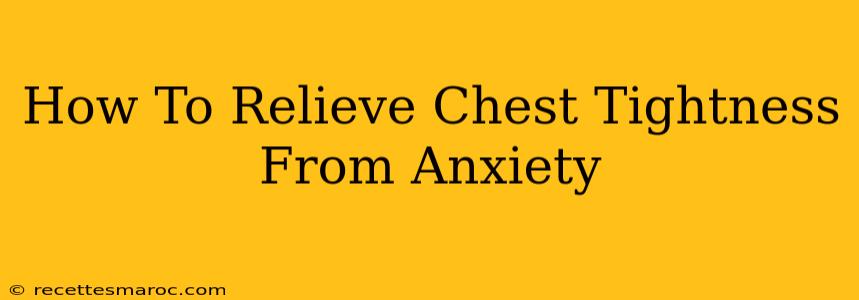Chest tightness is a common symptom of anxiety. That feeling of pressure or squeezing in your chest can be incredibly distressing, making it hard to breathe and focus. But the good news is that there are many ways to manage and relieve this uncomfortable sensation. This guide will explore effective techniques to help you cope with chest tightness caused by anxiety.
Understanding Anxiety-Induced Chest Tightness
Before diving into solutions, it's important to understand why anxiety causes chest tightness. When you experience anxiety, your body releases stress hormones like adrenaline and cortisol. These hormones trigger your "fight or flight" response, leading to physical changes such as:
- Increased heart rate: Your heart beats faster to pump more blood to your muscles.
- Rapid breathing: Your breathing becomes shallow and rapid (hyperventilation).
- Muscle tension: Your muscles, including those in your chest and shoulders, tense up.
This combination of a faster heart rate, rapid breathing, and muscle tension can create the feeling of chest tightness or pressure. It's important to remember that while it feels alarming, this tightness is usually not indicative of a heart problem.
Effective Ways to Relieve Chest Tightness from Anxiety
Fortunately, several strategies can help you manage and alleviate chest tightness related to anxiety. Here are some proven methods:
1. Breathing Exercises: Your First Line of Defense
Deep, controlled breathing is arguably the most effective way to combat anxiety-induced chest tightness. Rapid, shallow breathing exacerbates the problem, so focusing on slow, deep breaths helps regulate your nervous system. Try these techniques:
- Diaphragmatic breathing (belly breathing): Place one hand on your chest and the other on your belly. Inhale deeply through your nose, allowing your belly to rise while your chest remains relatively still. Exhale slowly through your mouth, feeling your belly fall.
- Box breathing: Inhale slowly to a count of four, hold for four, exhale slowly for four, and hold for four. Repeat this cycle several times.
- 4-7-8 breathing: Inhale deeply through your nose for a count of four, hold your breath for seven, and exhale slowly through your mouth for eight.
2. Progressive Muscle Relaxation
Progressive muscle relaxation involves systematically tensing and releasing different muscle groups in your body. This helps release physical tension, which often contributes to chest tightness. Start with your toes and work your way up to your head, tensing each muscle group for a few seconds before releasing.
3. Mindfulness and Meditation
Mindfulness techniques, such as meditation, can help you become more aware of your physical sensations without judgment. This can reduce the anxiety response and the associated chest tightness. There are many guided meditation apps and resources available online to help you get started.
4. Physical Activity
Regular exercise is a fantastic stress reliever. Even moderate physical activity, like a brisk walk, can help reduce anxiety symptoms and improve your overall mood. Aim for at least 30 minutes of moderate-intensity exercise most days of the week.
5. Lifestyle Changes
Certain lifestyle factors can exacerbate anxiety. Consider these changes:
- Improve sleep hygiene: Aim for 7-9 hours of quality sleep per night.
- Limit caffeine and alcohol: These substances can heighten anxiety symptoms.
- Eat a healthy diet: Nourishing your body with healthy foods can improve your overall well-being.
6. Seeking Professional Help
If chest tightness is persistent, severe, or significantly impacting your daily life, it's crucial to seek professional help. A therapist can teach you coping mechanisms, such as cognitive behavioral therapy (CBT), which is very effective in managing anxiety. A doctor can rule out any underlying medical conditions and may prescribe medication if necessary.
When to Seek Immediate Medical Attention
While anxiety-induced chest tightness is usually benign, seek immediate medical attention if you experience:
- Sudden, severe chest pain: Especially if accompanied by shortness of breath, sweating, or nausea.
- Chest pain that radiates to your arm, jaw, or back.
- Difficulty breathing that worsens progressively.
Remember: You are not alone. Many people experience anxiety and chest tightness. By using these techniques and seeking support when needed, you can effectively manage your symptoms and improve your quality of life.

